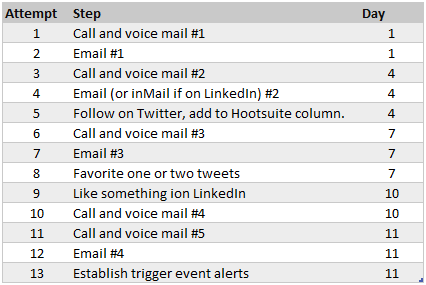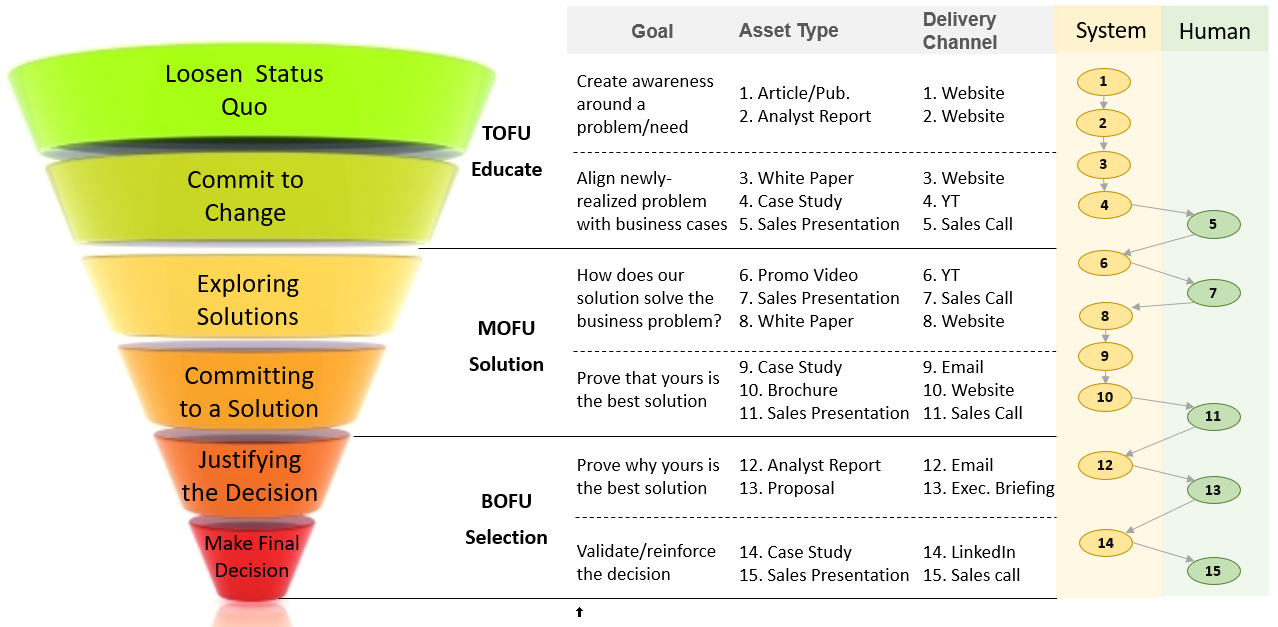B2B Lead Generation
B2B lead generation is relationship building. You must deliver value in stages to build trust. The currency of value is content & information; The right content delivered at the right time. You work to earn the right, over multiple online contacts, to ask for a meeting or time commitment to evaluate your offering in detail.
The biggest mistake many companies make with their buying journey is trying to move prospects along too far and too fast. Sometimes three steps are faster than one to help a prospect understand a problem, commit to change and commit to the process of buying. Marketers are the champion of the customer.
The high-level, triple goals of B2B marketing are:
- Initiating contact & turning prospects into sales opportunities.
- Categorizing prospects into buckets: Self-serve (small $ opps.), Sales-ready contacts (big $ opps.), prospects not ready to act & those not-worth-pursing.
- Continued support after the hand-off to sales. There continue to be actions you can automate to increase Opp>>Win ratios.
The following is a hybrid mash-up of several popular B2B funnels. I've incorporated goals, asset types, and delivery channels for a standard B2B buyer journey. Details vary by company & industry but stages & principles remain constant. Below the image is a simplified step-by-step process to make this flow a reality. Follow the embedded links for additional details on supporting processes.
Prospects>>Leads>>Opportunities>>Win/Close
Step 1: Develop Objectives & Goals. Quantify the upstream pipeline needed to meet sales expectations. Do a work back from revenue expected using AOV, Lead/Opp ratio (5% if unknown), Opp/Close ratio (25% if unknown), and average sales cycle length in months. Calculate a cost per MQL goal by dividing Media Spend Budget by Leads needed). These data points determine the scale & scope of campaigns required.
Step 2: Target Audience.
- Develop personas & journey maps. It is critical to clearly articulate the primary pain point your content must address to satisfy the goal associated with each stage of the 6-stage funnel. Sales team input is essential.
- Collect content ideas. 1) Review pre-existing content, including any analytic data related to each piece. 2) Do a competitive scan of competitive sites, LinkedIn posts, and ads being run; Note how competitive content positions them.
- Find a starting point for prospecting. A go-to is to get the names of 10-15 buying managers of current clients. Find their LI profiles and build a list of overlapping groups they follow. This can be the initial “fishing” ground. Refine & expand targeting as you turn prospects into qualified leads.
Step 3. Campaign Development. Modify the funnel grid above to customize & map your assets & channels to specific content pieces & engines (FB, AW, email, etc…). Add columns to describe the core idea of each content asset and another column to describe (briefly) how each asset addresses the corresponding pain point. Review, in detail, with sales. Primary questions to ask are 1) does this provide value to the buyer at each point in their journey? 2) are all major paint-points in the typical journey addressed? and 3) are you asking for contact information at the right time to keep moving forward.
Note: It is preferable to leverage multiple channels simultaneously to move through a stage. Learning & acceptance are accelerated by the content being seen multi-channel.
Step 4 - Campaign Plan, Execution. Configure delivery. Each deliverable requires a trigger. When using multi-channel campaigns, it’s critical to bring the user to an LP where pixels (LI, FB, AW) move the user from one audience down to the next. Ensure exclusions from the completed steps audience pool are synched across channels. For human events (sales calls etc…) manual intervention is needed.
Bonus: While collaborating with sales in step 3, document & align on sales follow-up procedure. It’s critical that each lead be follow-up consistently and in a timely manner. Here is a suggested 11 day, 13 step process, to use as a starting point for discussion if sales do not have a formal process.


